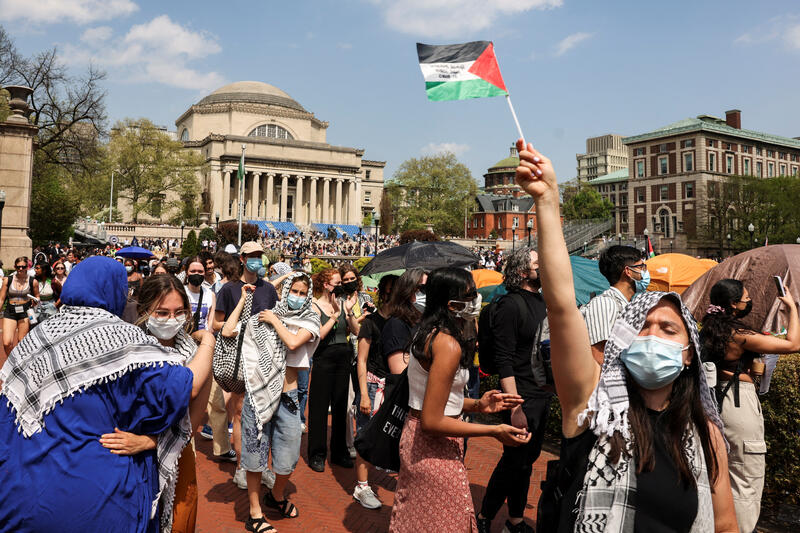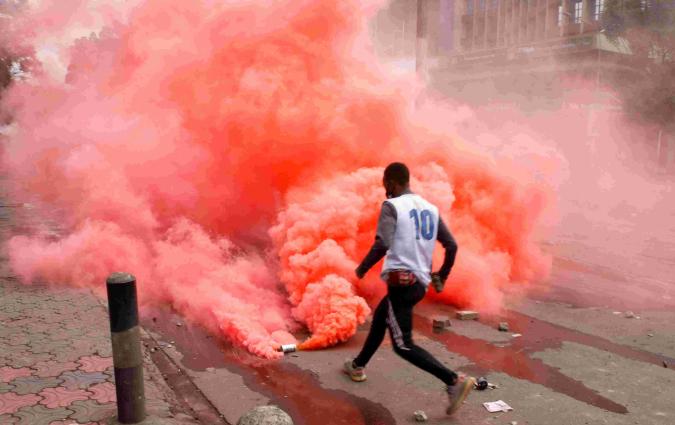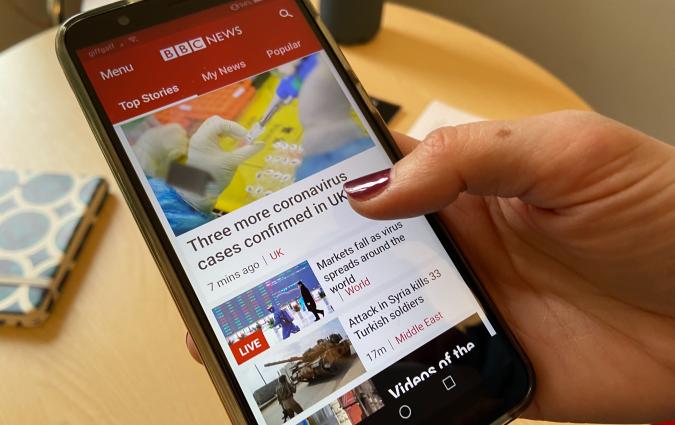“To be of use when things are so chaotic was really great” – How student journalists covered US campus protests

Pro-Palestinian protests on Columbia's campus. Credit: Reuters/Caitlin Ochs
“One day we were living our normal life and the next day we were 24/7 at the encampment, working constantly.” That’s how 27-year-old Alyssa Anderson described her deep dive into covering the protests against the war in Gaza at Portland State University. She is studying for a Master’s in English and is a news editor at Vanguard, the university’s student newspaper, where she's covered the unrest on campus for the past few weeks.
Some of Vanguard’s prior articles focus on important, but undramatic stories: funding announcements, new legislation, the closure of campus food carts. But with Gaza solidarity encampments popping up across the country and following a tradition of student activism, Vanguard journalists “expected something like this was going to happen.” A week of rapid developments culminated in police arriving on campus. That was when “all hell broke loose,” Anderson says.
She describes covering pro-Palestinian protests and the response to them both as “horrifying and probably traumatising” and something you and your team would want to do “for the rest of our lives”. These words sum up the mix of emotions that student journalists have felt across the United States in recent weeks. “To be of use in a time where things are so chaotic was really great,” Anderson says.
I spoke with Anderson and two student journalists from other campuses about how they covered the events surrounding the Gaza solidarity encampments in the United States, what they did to address rampant misinformation, and how they ensured their own safety and wellbeing in the midst of it all.

Reporting it straight. "We established ourselves as reliable and timely"
Students at Columbia University were among the first to set up an encampment in mid-April. Their goal was to demand the university divest economically and academically from Israel. Francesca Maria Lorenzini, a 23-year-old Italian student finishing a master’s at Columbia Journalism School, had been studying the topic of breaking news in her classes when the encampment was established.
“We came into campus, we found the encampment and my professor was like, ‘Okay, guys, now you have real breaking news,’” she recalls. Lorenzini covered events at Columbia including the first few days of the encampment, the denunciation of protests by House Speaker Mike Johnson and the occupation of the Hamilton Hall building. She also filmed police officers who arrived on Columbia’s Morningside Heights campus on 30 April and arrested 46 protestors.
Timeline of protests at these campuses
Columbia
City College New York
Portland State
As the media were temporarily restricted from entering Columbia, Lorenzini says she and her colleagues at City Newsroom, a news outfit run by 12 twelve CJS students and supervised by some of its professors, had a clear advantage over established news organisations, especially at the beginning of the protests.
“Being student reporters helped us because it gave us unprecedented access to the encampment. In the first [few] days, the media was not allowed on campus. Eventually, they were allowed, but only between 2 and 5pm.” She and a colleague divided their reporting duties between them and were careful of not trying to cover everything in order to avoid burnout.
But it wasn’t just access to the campus that gave her and her team an edge over their professional colleagues. Protestors were more willing to speak with her, feeling they would get a more honest hearing. “Because of the portrayal by the mainstream media, protesters were not really willing to talk to external outlets,” she says. Lorenzini singles out Al Jazeera for doing a better job than most news media in their coverage as it “focused more on the reasons why students were protesting.”
Some protestors were still wary of speaking on the record or sharing personal details. Organisers asked her to stick to certain rules like not filming people close up or identifying them if they preferred to remain anonymous. Lorenzini has “mixed feelings” about restrictions on her freedom to cover events taking place in a public space. As much as she would have liked to cover everything she saw or heard, she says she understood the protestors’ caution, especially as some had received death threats.
In Portland, Anderson says she and her team of 16 at PSU’s Vanguard had earned the trust of the protestors by building up relations with them over time. When they were shunning other media organisations, “they were inviting us in and let us be there the whole time.” She believes the protestors viewed them as impartial actors who had no incentive “to sensationalise anything, because it wouldn't have gotten us anywhere.”
Anderson shares some of the protestors’ frustration with the tone of media coverage. Although events in Portland didn’t garner the same national and global headlines as those on campuses in New York or Los Angeles, for example, she says that even local media coverage was deeply flawed and “lacked balance.”
“It was very clear to me from the beginning that several of these outlets (though not all) were more interested in publishing a buzzy story rather than keeping the public safe and informed,” Anderson says.
Having much in common with student protestors, Lorenzini says she had to consciously withdraw herself from the story emotionally to avoid the temptation to cover the story in a particular way. But being aware of her biases allowed her to report the story as straight as possible, in a ‘breaking news’ fashion. “To one extent, it was better, because it allowed me to report on it in a really neutral way. I was just saying what was happening,” she says.
The PSU Vanguard also leaned heavily on a breaking news format using Instagram to keep the university community informed.
“People have been very grateful and supportive, because we were the only people providing regular updates. And luckily, we were able to establish ourselves as reliable and timely and so people really engaged with that.”
A glance at Vanguard's Instagram account shows the depth of this engagement. The Reels they’ve published on the platform since 26 April, just after the encampment was established, have been viewed nearly 1.4 million times, with some individual videos surpassing 100,000 views. Their videos feature broadcast-style reports to camera with information such as police whereabouts, updates on negotiations between the parties involved, as well as live footage of unfolding events.
On 2 May, when Portland Police entered the university to remove protestors occupying a campus library, Anderson says, “we were able to hop on roughly every hour, sometimes more frequently, and just say, ‘This is what's going on.’” Their number of Instagram followers has grown five-fold in the space of a few weeks.
“We have a website," she says, “but a lot of our [audience] comes from Instagram. Instagram is a huge asset for us.”
Staying safe: "That was just too much"
Fifteen minutes north of Columbia, 19-year-old Leon Orlov-Sullivan, editor-in-chief of The Campus magazine, covered the events unfolding at City College New York, which is part of the state’s public higher education system. Founded in 1907, The Campus is the oldest student news outlet within the university but is run on a small budget with just three staff led by Orlov-Sullivan, a physics undergraduate who was introduced to journalism by the previous Campus editor and covered arts and entertainment before becoming editor-in-chief.
Orlov-Sullivan says he never felt unsafe while covering the encampments themselves. But when the police came onto campus, he was more concerned. “I was kind of worried about whether or not I was going to be arrested,” he says. “I was determined to stay and report until I was actually told to leave.”
Hearing that many people (including a journalist) were getting detained, tackled and pepper sprayed, Orlov-Sullivan was torn between concerns for his own well-being and a desire to cover the events.
Routine campus journalism wouldn’t usually call for the use of press vests. But these were an important part of the safety kits for student reporters covering the encampments in the US. In Portland the Vanguard provided their two youngest reporters with them. “The rest of us had no way to identify ourselves as journalists, which was pretty bad,” Anderson says. “But we tried to keep people with vests with people without them, so we could sort of stick together.”
Anderson and her team kept in contact through Slack and social media, checking in with each other more frequently when the police arrived on campus. Additionally, they wrote on their arms the contact number of a faculty member who was willing to help them in case they encountered difficulties.
Although they had a number of reporters to cover events at Portland State, the rapidly evolving situation meant reporting duties were assigned to “whoever was available” and for however long they could stick it out, which placed a lot of pressure on some of their journalists. Anderson recalls arriving at the encampment at 9pm one night and not leaving till 6am the next morning. “If something like this happens again, we have to establish a better system,” she says.
Being based at the prestigious Columbia Journalism School meant Lorenzini and her fellow reporters were able to take more thorough measures to ensure their safety. Like Anderson, Lorenzini was encouraged to write an emergency number on her arm, in her case the school’s referral lawyer, and they were also issued with wearable signs identifying them as student press. Additionally, they met with their journalism professors prior to the NYPD arriving on campus to discuss the safety precautions they should take.
When I first approached Anderson and her team for an interview, she says she and her team were recovering from a hectic period covering the protests and even facing threats by a counter-protestor. A man had driven towards a crowd of demonstrators before stopping short, getting out and assaulting them with pepper spray. It later emerged the man had tagged the newspaper in his social media story with an accompanying ‘middle finger’ emoji saying he was on his way.
“Once we heard that, we all were like, ‘We can't do this. We have to stop. Because that was just too much',” Anderson says. In one video, fellow Vanguard reporter Sergio Cervantes tells the audience that after a period of 24/7 reporting and for the sake of their physical and mental health they have “decided to take a step back from reporting.” The next video was not published until the following day.
Addressing misinformation
For these student journalists, debunking falsehoods has been a key goal of their work. “There was so much misinformation going around, especially stuff that was absolutely insane. That's why people were really grateful that we were able to just say, ‘This is what's going on,’” says Anderson. Much of the narratives around the protests, including from local authorities and politicians, focused on the levels of violence, which Anderson says was unfair. “People were painting it like, ‘These are really violent, bad people’ and like ‘The campus is a very dangerous place’; and we posted videos and they were like, ‘They are doing open mic night’.”
Anderson explains she had to dispel false claims that protestors were bringing children to the front of the barricades to use as human shields. “[I’m] like, ‘No, that’s not happening’,” she says.
At Columbia, where much of the world’s news agenda was focused for a week, Lorenzini says that while “some media portrayed protestors as terrorists and dangerous people, everything was really peaceful” listing activities like yoga or gatherings marking the Jewish day of rest, Shabbat, to underline her point.
Meanwhile, at City College, Orlov-Sullivan also says he was also able to directly address false claims around who was being arrested. A statement sent to faculty said that only those who had occupied and damaged the college’s financial aid office were arrested and that protestors in the main encampment were instead just given court summonses. However, in a piece for The Campus, Orlov-Sullivan wrote that he saw “dozens of activists being arrested” at the encampment itself for refusing to leave.
A desire to ensure accountability from all stakeholders involved in the story is what led Orlov-Sullivan to live-stream and identify individual police officers on his campus. During one stand off, he read out officers’ badge numbers while viewers checked their records for disciplinary charges they were facing. At this moment, he says, not only was he wearing a journalist’s hat but also the hat of a concerned citizen and fellow student.
“I wanted to have reporting on officers who had previous violations, particularly for abuse of force, which some of them did have,” he says.
Lessons learnt: "I grew a lot as a reporter"
Fifty-six years after the momentous campus protests against the Vietnam war, these student journalists reported for weeks on a story which may have a similar resonance in an election year and in the years to come.
Lorenzini thinks she “grew a lot as a reporter in the last few weeks,” finding herself covering the events of “the real world” and not just her campus bubble. Looking back, she realises she was able to balance her studies with her reporting duties by working closely with a classmate to achieve the coverage they wanted. In contrast, some of her colleagues worked solo and the story “really consumed them,” she says, at the expense of their academic work.
Soon to be in the job market, she thinks she should probably “show off” the fact that the Pulitzer Prize Board acknowledged Columbia’s student journalists for their “extraordinary real-time reporting” during the saga.
Reflecting on his experience covering events at CCNY, where 170 people were eventually arrested, Orlov-Sullivan says he’s unlikely to regret it, despite the pressure on himself and his studies, for which he had to seek extensions.
“Journalism has taken up a lot of my time, especially when we're so short-staffed. [But] I feel like I'm not going to really look back and think, ‘Man, I should have done that assignment instead of writing that article.’ But maybe I will,” he says. Even though he doesn’t want to become a journalist, the whole exercise has made him respect journalistic values even more.
“This has increased my belief in the importance of journalism and the importance of people who are unbiased and able to set the record straight in the face of misinformation from biased parties,” Orlov-Sullivan says. “But a career in journalism? I'm not sure.”
Anderson and her fellow students at Portland State’s Vanguard are now even more motivated to pursue journalism as a profession. “When everything was unfolding,” she says, “and we were all running around with the police, trying to capture footage, a lot of us were like, ‘We want to do this for the rest of our lives’.”
In every email we send you'll find original reporting, evidence-based insights, online seminars and readings curated from 100s of sources - all in 5 minutes.
- Twice a week
- More than 20,000 people receive it
- Unsubscribe any time
signup block
In every email we send you'll find original reporting, evidence-based insights, online seminars and readings curated from 100s of sources - all in 5 minutes.
- Twice a week
- More than 20,000 people receive it
- Unsubscribe any time






